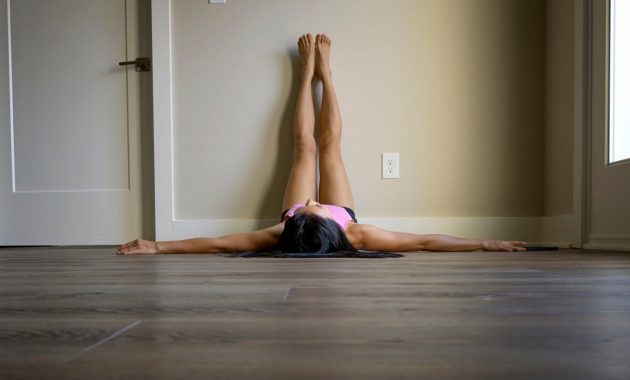Viparita karani asana helps to keep stress at bay and improves overall sleep. Here are all the benefits of the legs up the wall pose and the steps to do it properly.
After a hectic and tough day, if you want to relax and soothe your body and mind, incorporating viparita karani asana can be helpful. This pose increases flexibility, strength, and balance while promoting relaxation and stress alleviation. It also improves posture, relieves chronic pain, and enhances immunity without requiring any fancy or expensive equipment. Also known as the legs up the wall pose, it is one of the best yoga poses for sleep. The stretched legs and feet help to relieve tension, which leads to relaxation and a good night’s sleep, which is why asana is also known as sleep yoga. This pose uses a wall to stretch your legs up against, allowing gravity to slowly and gently facilitate venous return. Here’s how to do it properly and all the benefits it has to offer.
What is legs up the wall or viparita karani?
The name viparita karani asana comes from Sanskrit: “viparita” meaning turned around, reversed, or inverted “karani” meaning doing, making, or action, and “asana” meaning pose. “It is an inverted pose where you lie on your back with your legs extended up a wall, forming an L-shape with your body. The pose is considered a mild inversion that does not require much strength or flexibility, making it accessible to many practitioners”, says yoga expert Himalayan Siddhaa Akshar.
Benefits of legs up the wall or viparita karani
Here are the potential benefits of viparita karani or legs up the wall pose:
1. Keeps stress at bay
A study published in the International Journal of Yoga found that regular yoga increases focus, reduces stress and anxiety, and enhances overall well-being. Viparita karani activates the parasympathetic nerve system, which controls our “rest and digest” condition. This pose calms the nervous system and can help relieve muscle tension, headaches, and fatigue.

2. Improves blood circulation
“Legs up the wall invert the body, promoting blood flow back towards the heart from the legs and feet. This can be especially helpful for people who sit or stand for extended periods, as it reduces swelling and the risk of blood clots,” explains the expert.
Also Read

3. Reduces back pain
A study published in the Journal of Orthopedic Rheumatology found that regular practice of yoga can help reduce back pain. So, if you are looking for ways to reduce back pain, incorporating legs up the wall pose can be helpful. This pose gently stretches and decompresses the lower back, relieving tension and pain in the lumbar spine.
4. Enhances flexibility
Regular yoga practice may improve flexibility and balance, according to a study published in the International Journal of Yoga. This pose can gently stretch the hamstrings, calves, and glutes, improving overall flexibility in the lower body. Thus, before a dreadful workout session, you can practice viparita karani to enhance and improve your flexibility.
5. Improves sleep
Daily struggle of life takes away our peace of mind and sleep, fret not! Incorporating legs up the wall pose can help to sleep peacefully. A study published in the Brain Behaviour and Immunity Integrative found that Yoga has proven the potential to reduce sleep onset delay, increase sleep length, and improve sleep quality. By promoting relaxation and reducing stress in viparita karani asana, this pose can make it easier to fall asleep and improve overall sleep quality.
6. Lymphatic drainage
“Legs up the wall stimulate the lymphatic system, which aids in the removal of waste and toxins from the body. This can improve the immune system and overall well-being, explains the expert.
How to do viparita karani asana or legs up the wall pose?
Here is a complete guide on how to do viparita karani asana or legs up the wall pose, as explained by the expert.
- Step 1: Start by sitting on a mat or floor close to a wall, with your hip touching the floor or mat.
- Step 2: Slowly lie back while swinging your legs up the wall in one smooth motion.
- Step 3: Adjust your position so your buttocks are as close to the wall as comfortable. They do not have to touch the wall.
- Step 4: Extend your legs up the wall, keeping them straight but not locked.
- Step 5: Rest your arms by your sides, palms facing up.
- Step 6: Close your eyes and focus on your breath.
- Step 7: Hold the pose for 5-20 minutes, or as long as comfortable.
- Step 8: To come out, bend your knees and roll to one side before slowly sitting up.
Breathing pattern to perform viparita karani
In this pose, focus on deep, slow breaths:
- Inhale deeply through your nose, allowing your belly to expand.
- Exhale slowly through your nose, feeling your belly contract.
- Aim for a 1:2 ratio of inhale to exhale (for example: inhale for 4 counts, exhale for 8 counts).
- Continue this breathing pattern throughout the pose, allowing it to deepen your relaxation.

Side effects of legs up the wall pose or viparita karani
- While this pose is generally considered safe, some people might experience:
- Tingling in the legs due to altered blood flow.
- Slight dizziness when coming out of the pose (rise slowly)
- Discomfort in the lower back (can be alleviated by placing a small cushion under the lower back)
Always listen to your body and alter the pose as needed to ensure a safe and fruitful practice. It is also vital to approach it carefully and with the assistance of an expert who can give you appropriate advice and help you prevent injury.
#Viparita #Karani #asana #benefits #legs #wall #pose
